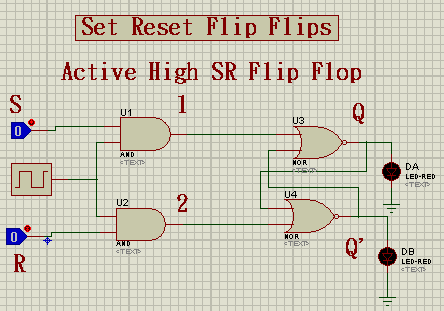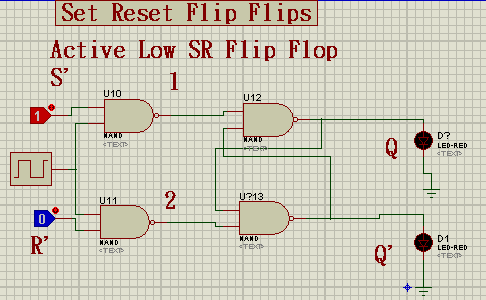 Hello Learners! welcome from the team of The Engineering Projects. We hope you are having a productive day. We are working on a series of Blogs based upon the core knowledge about Digital Logic Gates and Circuits. In this tutorial, we’ll know about the SR Flip Flops and after brief introduction we will simulate SR Flip Flops in Proteus. Let’s have a glimpse on the topics of today:
Hello Learners! welcome from the team of The Engineering Projects. We hope you are having a productive day. We are working on a series of Blogs based upon the core knowledge about Digital Logic Gates and Circuits. In this tutorial, we’ll know about the SR Flip Flops and after brief introduction we will simulate SR Flip Flops in Proteus. Let’s have a glimpse on the topics of today:
- What are Flip Flops?
- What are the types of Flip Flop?
- How does we design the Truth Table of SR Flip Flops?
- What are further classes of SR Flip Flips?
- Implementation of SR Flip Flops in Proteus.
Flip Flops
Flip Flops are extremely important Circuits of Digital Logic Design. We Introduce the Flip Flops as:
“Flip Flops are type of sequential Logic Circuit that contain two stable states “Zero” and “One” (because of the binary system). It is often used as Storage device and each state of Flip Flop stores one bit.”
They are the building blocks of the Electronics and play an important role in the world of Logic Circuits. Being the Binary circuits, they are essential for the computation in the computer system.
The Inputs of the Flip Flops are named as “S” AND “R” that stands for Set and Reset respectively. There are two Outputs of the Flip Flop called Q and Q’. As the name suggest itself, both the outputs are the Inverse of Each Other.
the Flips Flop are sequential Logic Circuits that mean they use a Clock called as “CLK” in the circuit. the Function of clock is to synchronize the circuit. The Phenomenon in which the clock signal is change its value i.e, from 0 to 1 or from 1 to 0, is called the edge of the clock.
DID YOU KNOW?????????????????
Flip Flops are also called as Bipolar Multi-vibrator because they can store the both the Conditions of the Binary system.
When we say that Flip Flops are the Storage Devices, we mean that they does not only calculate the output from the present data, but they can also work with the data stored previously in the Flip Flops.
Types of Flips Flops
When we talk about the types of Flip Flops, we consider mainly Four types of Flip Flops as follow:
- SR Flip Flop
- JK Flip Flop
- D Flop Flops
- K Flip Flops
These kinds are same in the composition of circuits, but the working, Construction and the results are different from each other.
We’ll Describe the structure of each of them along with the simulation for best concepts one after the other.
DID YOU KNOW??????????????
Flip Flops can maintain a binary state as long as there is power in the circuit, therefore can store the Data.
SR Flip Flop
The full name of SR Flip Flop is Set Reset Flip Flop. In this type of Flip Flop the Value of Output Q depends upon the Value of the “S” input. once the input of the SR Flip Flop goes high (When S and R are high) the output goes to infinity or undefined therefore this Circuit is used to store the information.
Truth Table of SR Flip Flop
When we talk about the Truth Table of SR Latch, we find some unique behavior. The Interesting point about the SR Latch is when Set and Reset are LOW i.e, 0 then the value of the Output does not change. The circuit does not show any alternation. Moreover, when the values of inputs are HIGH, the output is undefined as discussed above. Hence the design of Truth Table of SR Flip Flop is as follow:
| S | R | Q | Q’ |
| 0 | 0 | No change | No change |
| 0 | 1 | 0 | 1 |
| 1 | 0 | 1 | 0 |
| 1 | 1 | Undefined | Undefined |
The SR Flip Flops are further classified into two main types:
- Active High SR Flip Flops.
- Active Low SR Flip Flops.
we’ll learn about their details and the structure of the circuit.
Active High SR Flip Flops
The Active High SR Flip Flops are the one in which the Set input and the output terminal Q collaborate with each other. When the S is 0, the output Q is 1 and vise versa.
We know that Q is always opposite to Q’ hence we get the output as expected. Let’s Look at the circuit of Active High SR Flip Flop and work at it in Proteus ISIS.
Active High SR Flip Flops in Proteus ISIS
- Fire Up your Proteus Software.
Material Required
- AND Gate
- NOR Gate
- NAND Gate
- Logic Toggle
- LED-Red
- Clock
- Ground Terminal
- Connecting Wires
- Click at the “P” button and Write AND Gate, NOR Gate, Logic Toggle, LED-Red, Clock one after the other and choose them through Enter button.
- Choose AND Gate from the Pick Library section and arrange two of them at the working area.
- Get two NOR Gates and arrange them just after the AND Gates.
- Get two Logic Toggles and Arrange them just before AND Gate for input.
- Choose two LEDs and fix them just after the NOR Gates.
- Ground each LED through ground Terminal Found in the Terminal modes at the left side of screen.
- Use a Clock in between AND Gates.
- Join all the components through wires just like the image given below:
Now Pop the Play button.
Alter the Values of Input and observe all the outputs at each Logic Gate. You will get following Truth Table:
| S | R | 1 | 2 | Q | Q’ |
| 0 | 0 | 0 | 0 | No change | No change |
| 0 | 1 | 0 | 1 | 0 | 1 |
| 1 | 0 | 1 | 0 | 1 | 0 |
| 1 | 1 | Undefined | Undefined | Undefined | Undefined |
DID YOU KNOW???????????
The inputs of Active Low SR Flip Flops are denoted by a a bar , a complement or a “not” word along with their name.
Active Low SR Flip Flop
The Active Low SR Flip Flops have the same output as their twin Circuit Active High SR Flip Flop. The difference is in the construction of the circuit.
We use the NAND Gate in the Construction of Active Low SR Flip Flop. all other arrangements and devices are same as the previous one.
Simulation of Active Low SR Flip Flop in Proteus ISIS
- In the above Circuit of Active High SR Flip Flop, pop the left click at gate 1.
- Left click>Delete the Gate 1.
- Repeat the same step with other gates as well.
- Add the NAND gate in all the places.
- Arrange the system again as shown in the figure below:
When we Test the Active Low SR Flip Flop we get the following outputs:
| S’ | R’ | 1 | 2 | Q | Q’ |
| 0 | 0 | 0 | 0 | No change | No change |
| 0 | 1 | 1 | 1 | 0 | 1 |
| 1 | 0 | 1 | 1 | 1 | 0 |
| 1 | 1 | Undefined | Undefined | Undefined | Undefined |
Hence this is another form of SR Flip Flop.
Consequently, we learned about the Flip Flops, we saw what are its types , saw the subclasses of the Flip Flop and designed two types of SR Flip Flops in Proteus ISIS.
Stay tuned for the other tutorial in which we’ll solve the problem of undefined conditions of Flip Flops.
JLCPCB – Prototype 10 PCBs for $2 (For Any Color)
China’s Largest PCB Prototype Enterprise, 600,000+ Customers & 10,000+ Online Orders Daily
How to Get PCB Cash Coupon from JLCPCB: https://bit.ly/2GMCH9w
The post Implementation of SR Flip Flops in Proteus appeared first on The Engineering Projects.



No comments:
Post a Comment